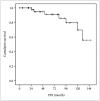Treatment Outcome of Gamma Knife Radiosurgery for Petroclival Meningiomas: Retrospective Analysis of a Single Institution Experience
- PMID: 33118341
- PMCID: PMC7595854
- DOI: 10.14791/btrt.2020.8.e16
Treatment Outcome of Gamma Knife Radiosurgery for Petroclival Meningiomas: Retrospective Analysis of a Single Institution Experience
Abstract
Background: Although Gamma Knife radiosurgery (GKRS) has been widely used for intracranial meningiomas as an alternative or adjuvant treatment, guidelines have not been established for the selection of patients with petroclival meningioma (PCM) for GKRS. In this study, we reported the factors related to tumor progression and postoperative complications in PCM patients treated by GKRS, with a review of the literatures.
Methods: Between 2004 and 2019, 64 patients (52 patients for alternative and 12 patients for adjuvant treatment) with PCM underwent GKRS in our institution. The clinical and radiological factors were retrospectively analyzed. The mean radiologic follow-up duration was 58.4 months (range, 6-164 months). The mean tumor volume and diameter before GKRS were 13.4 cm³ and 2.9 cm, respectively. The median marginal dose was 12 Gy (range, 10-14 Gy) with a 50% median isodose line. Fractionation was used in 19 cases (29%, two fractionations in 5 cases & three fractionations in 14 cases).
Results: Progression was noted in 7 cases (10.9%) and the progression-free survival rates were 91.1% at 5 years and 69.6% at 10 years. Although large in volume, moderate to severe peritumoral edema and male gender were somewhat related to progression, they did not reach statistical significance. Ten patients (15.6%) developed complications after GKRS. The most common complication was cranial nerve deficit (n=8), followed by hemiparesis, cognitive dysfunction, and hydrocephalus. Large size (maximal diameter ≥5 cm) [hazard ratio (HR) 0.091, 95% confidence interval (CI) 0.014-0.608; p=0.013] and multiplicity (HR 0.102, 95% CI 0.018-0.573; p=0.009) were independent factors for developing complications after GKRS.
Conclusion: GKRS can be considered an effective and safe treatment for large-volume PCM. However, for patients with large size or multiple masses, the treatment method should be determined with caution because the probability of complications after GKRS may increase.
Keywords: Bone, petrous; Clivus; Gamma knife radiosurgery; Intracranial meningioma; Postoperative complications; Treatment outcome.
Copyright © 2020 The Korean Brain Tumor Society, The Korean Society for Neuro-Oncology, and The Korean Society for Pediatric Neuro-Oncology.
Conflict of interest statement
The authors have no potential conflicts of interest.
Figures





References
-
- Little KM, Friedman AH, Sampson JH, Wanibuchi M, Fukushima T. Surgical management of petroclival meningiomas: defining resection goals based on risk of neurological morbidity and tumor recurrence rates in 137 patients. Neurosurgery. 2005;56:546–559. - PubMed
-
- Sekhar LN, Swamy NK, Jaiswal V, Rubinstein E, Hirsch WE, Jr, Wright DC. Surgical excision of meningiomas involving the clivus: preoperative and intraoperative features as predictors of postoperative functional deterioration. J Neurosurg. 1994;81:860–868. - PubMed
-
- Kim JW, Jung HW, Kim YH, et al. Petroclival meningiomas: long-term outcomes of multimodal treatments and management strategies based on 30 years of experience at a single institution. J Neurosurg. 2019;132:1675–1682. - PubMed
-
- Flannery TJ, Kano H, Lunsford LD, et al. Long-term control of petroclival meningiomas through radiosurgery. J Neurosurg. 2010;112:957–964. - PubMed
-
- Roche PH, Pellet W, Fuentes S, Thomassin JM, Régis J. Gamma knife radiosurgical management of petroclival meningiomas results and in dications. Acta Neurochir (Wien) 2003;145:883–888. - PubMed

